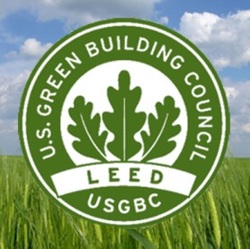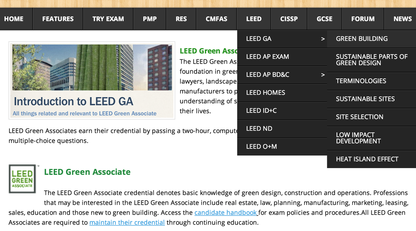The value of a LEED Certification

The not-for-profit U.S. Green Building Council (USGBC) has devised a multidimensional rating system that judges the proposed Leadership in Energy and Environmental Design (LEED) which promotes construction that is environmentally responsible, profitable and, in the words of its mission-statement, creates healthy places to live and work. Its worthwhile goal aside, of interest to economists is the way the Council is going about this. LEED certification promotes the voluntary private-provisioning of public goods via non-enforceable industry self-regulation. Builders willfully submit the details of proposed projects to a third-party trade association which reviews the specs and publically vouches for the project's environmental bona fides. The award of a LEED certification first and foremost objectively evaluates the energy efficiency and eco-friendliness of a developer's latest project, elements that investors and tenants would otherwise have to take entirely on faith. The working definitions and standards of measurement applied benefit the industry, too, by technically 'raising the bar' participants aspire to and by increasing public awareness of and confidence in 'green' construction. Indeed, LEED certification may well become a widely accepted brand in itself, denoting environmental 'added value' to buyers. This, in turn, fosters a viable private-sector marketplace for green products.
The Business Case for LEED Certification
The business case for LEED certification rests entirely on the perceived benefits builders, owners and tenants associate with it. That and, of course, consumers' willingness to pay a premium for products that improve something we all share: The environment. Until very recently, there was scant evidence to suggest much prospect for the latter. If the sudden uptick in demand for 'hybrid' cars is any indication, the public-at-large may well be beginning to change its mind. Much as, ironically, the World Business Council (populated by the likes of DuPont, Con Agra and Chevron) started to very tentatively ten years ago by publically subscribing to the notion of eco-efficiency. Eco-efficiency endorses the use of fewer resources and emitting less pollution, not more, in a firm's quest to remain competitive. Ten years ago, by comparison, the value in going 'green for green's sake' was largely moral. Climate change's existence was still open to considerable doubt and its possible long-term ramifications chiefly of concern to individuals, academics and non-governmental organizations.
Basically, the whole point to initiatives like LEED is that private-sector competition can improve the quality of public goods, meet the greater society's needs in the process and make a profit through market mechanisms. Builders with a LEED certificate for example, can pursue what marketers refer to as a premium pricing strategy. Customers looking to 'go green' should be willing in effect to pay more for proven expertise in what's still, after all, a collection of emerging technologies. Not doing so exposes them to a much higher risk of ending up on the wrong side of some potentially expensive information asymmetries. Now some may calculate that the cost savings are well worth the risk, others not. But costs are only one side of the equation; revenues count as much if not more. Accordingly, how LEED certification figures into the value proposition builders pitch to developers, and they in turn pitch to renters and buyers, matters a great deal.
The more favorable the cost-benefit analysis of owning or renting a LEED-certified facility look, essentially, the more attractive its appeal. High oil prices and the likelihood of carbon taxes on greenhouse emissions make going 'green' an increasingly attractive investment. Tax breaks and other incentives might defray some of the additional upfront costs involved as well. Once completed, a green building's lower operating costs should pay dividends for years to come. And that sways many a purchase-decision because what counts the most is Return-On-Investment (ROI), the discounted present value of future cash flows. The promise of greater net income over the long-term improves a building's initial valuation and its eventual worth on the resale market. When it comes to product positioning, 'softer' factors such as the health of occupants protected from indoor particulates, the built-in cushion against unexpected oil shocks and, now, the innate appeal of 'going green' as a social value count as well. LEED certification will be a success when and if people strongly associate said benefits in exactly the same manner as popular brand names connote value and inspire customer loyalty. The price-tag might be a higher order of magnitude, but the principle's the same: Building trust in the quality of one's products makes many a sale.
(Local Economic Empowerment Development Strategy Certification, Francis Duffy)
The business case for LEED certification rests entirely on the perceived benefits builders, owners and tenants associate with it. That and, of course, consumers' willingness to pay a premium for products that improve something we all share: The environment. Until very recently, there was scant evidence to suggest much prospect for the latter. If the sudden uptick in demand for 'hybrid' cars is any indication, the public-at-large may well be beginning to change its mind. Much as, ironically, the World Business Council (populated by the likes of DuPont, Con Agra and Chevron) started to very tentatively ten years ago by publically subscribing to the notion of eco-efficiency. Eco-efficiency endorses the use of fewer resources and emitting less pollution, not more, in a firm's quest to remain competitive. Ten years ago, by comparison, the value in going 'green for green's sake' was largely moral. Climate change's existence was still open to considerable doubt and its possible long-term ramifications chiefly of concern to individuals, academics and non-governmental organizations.
Basically, the whole point to initiatives like LEED is that private-sector competition can improve the quality of public goods, meet the greater society's needs in the process and make a profit through market mechanisms. Builders with a LEED certificate for example, can pursue what marketers refer to as a premium pricing strategy. Customers looking to 'go green' should be willing in effect to pay more for proven expertise in what's still, after all, a collection of emerging technologies. Not doing so exposes them to a much higher risk of ending up on the wrong side of some potentially expensive information asymmetries. Now some may calculate that the cost savings are well worth the risk, others not. But costs are only one side of the equation; revenues count as much if not more. Accordingly, how LEED certification figures into the value proposition builders pitch to developers, and they in turn pitch to renters and buyers, matters a great deal.
The more favorable the cost-benefit analysis of owning or renting a LEED-certified facility look, essentially, the more attractive its appeal. High oil prices and the likelihood of carbon taxes on greenhouse emissions make going 'green' an increasingly attractive investment. Tax breaks and other incentives might defray some of the additional upfront costs involved as well. Once completed, a green building's lower operating costs should pay dividends for years to come. And that sways many a purchase-decision because what counts the most is Return-On-Investment (ROI), the discounted present value of future cash flows. The promise of greater net income over the long-term improves a building's initial valuation and its eventual worth on the resale market. When it comes to product positioning, 'softer' factors such as the health of occupants protected from indoor particulates, the built-in cushion against unexpected oil shocks and, now, the innate appeal of 'going green' as a social value count as well. LEED certification will be a success when and if people strongly associate said benefits in exactly the same manner as popular brand names connote value and inspire customer loyalty. The price-tag might be a higher order of magnitude, but the principle's the same: Building trust in the quality of one's products makes many a sale.
(Local Economic Empowerment Development Strategy Certification, Francis Duffy)


 RSS Feed
RSS Feed
